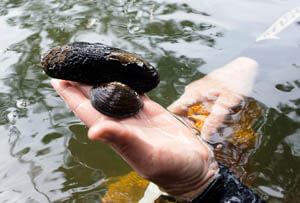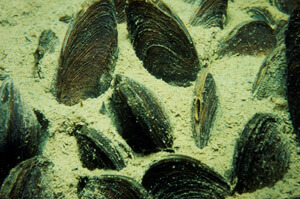Although similar in appearance to marine mussels, the 2 groups have been separated for at least 200 million years and have very different biology.
New South Wales has 8 species of freshwater mussels that live in coastal streams.

Freshwater mussels (Cucumerunio novaehollandiae and Alathyria profuga)
Where do they live?
The species of freshwater mussels found in Australia and New Guinea are unique to the region and are not found anywhere else in the world. Their closest relatives live in New Zealand and South America.
Mussels are most likely to be found in the middle or lower sections of permanently flowing streams. However, floodplain mussels (Velesunio ambiguus) are an exception; they can be found in temporary creeks and ponds, including farm dams, and they avoid strongly flowing rivers.
The stability of the stream bed is critical for mussels and the best habitats provide protection from scouring flows. These places have dense streamside vegetation and lots of large woody debris or boulders in the channel to stabilise the streambed sediments and provide refuges in times of flood. This is why mussels are usually patchily distributed within a section of stream. Shade from streamside vegetation helps to stabilise water temperatures and ameliorate water quality by shielding the stream from the sun.
Juvenile mussels spend the first few years of life within the stream bed, so streambed stability and sediment quality are important determinants of juvenile habitat. Organic sediments and places where the stream bed is clogged with fine silt are unfavourable for juvenile mussels.
The mussel life cycle
Freshwater mussels have an unusual life cycle. They can live from about 10 to 40 years. Females brood eggs in modified sections of the gills, called marsupia, where they develop into bivalved larvae, called glochidia, bearing a pair of hooks on the apex of each shell valve. Most species brood in spring and summer.
The glochidium is parasitic and must attach to the gills or fins of a fish to complete its development. Female mussels produce large numbers of glochidia but few find a fish host and even fewer survive to maturity. Species of Hyridella produce tens of thousands of glochidia in each brooding cycle and may breed repeatedly during the warmer months. In contrast, Cucumerunio novaehollandiae produces millions of glochidia but reproduces only once per season.
A wide range of native fish species, including smelt, gudgeons and Australian bass, are used as hosts, as well as some introduced species, including the eastern gambusia. Goldfish and common carp are not suitable hosts. This inter-dependence between mussels and fish means that the wellbeing of mussel communities is closely linked to the health of the resident fish community.
After detaching from their hosts, juvenile mussels burrow into the stream bed where they grow rapidly for a few years.
Why are they important?
Freshwater mussels are important for the environment in several ways.
As indicators of aquatic health
Mussels live in stable environments and are sensitive to pollution, so their presence indicates good conditions for other aquatic animals. They have a long life span and are sedentary, so when they disappear it is a warning that something is awry.
Their important ecological role
Mussels filter large volumes of water to extract their food, removing nutrients, algae, bacteria and organic detritus from the water. Mussel waste products are food for other animals and they, in turn, are food for water rats and platypus.
Their significant cultural value
Freshwater mussels were an important source of food for Indigenous Australians. Middens containing large numbers of mussel shells are widespread alongside rivers and lakes. Aboriginals also used mussel shells as tools.

Dense mussel bed filter large volumes of water and act as biological filters.
Threats to freshwater mussels and how you can help protect them
Mussels have been affected by changes to the Australian landscape since European settlement. Their numbers have declined in some NSW coastal rivers, including sections of the Hawkesbury-Nepean and Hastings River systems. Mussels have disappeared from some streams in the Hunter Valley and the south coast of New South Wales. Our understanding of the status of mussel populations in many streams is limited because very few surveys have been done.
Mussel populations have become fragmented, and remnant populations are often small and isolated from one another, as in the Hunter Valley. Mussels depend on fish for dispersal between habitats, but in many streams fish movements are restricted by dams, weirs or long stretches of poor habitat. Small, isolated populations have a higher risk of extinction than unfragmented populations.
Habitat degradation is caused by:
- dams and weirs, which are also barriers to fish movement
- high rates of stream erosion and sedimentation
- pollution
- siltation
- invasive aquatic weeds.
Habitat loss and fragmentation
Widespread removal of catchment and riparian vegetation has accelerated rates of stream erosion. Many rivers are now much wider and shallower than they were at the time of European settlement. Most of the eroded sediment has been stored in the middle to lower reaches of coastal streams simplifying aquatic habitats and producing shallow channels with highly mobile bed sediments. Removal of snags from rivers has compounded the problem.
Commercial sand and gravel extraction has also destabilised some streams by causing ‘head cutting’, a progressive upstream erosion of the stream bed which is later followed by streambank erosion and subsequent widening of the channel. For example, in the lower Wilson River, a tributary of the Hastings River on the mid-north coast, gravel extraction has degraded aquatic habitats for many kilometres upstream of the extraction point. Mussels have almost completely disappeared from the affected reaches.
Siltation of streams is associated with runoff from urban and agricultural lands. Roads, stock access tracks, cultivation and overgrazing contribute to siltation of the stream bed. Fine sediment can blanket the stream bed and suffocate adult mussels and interfere with their feeding. Juvenile mussels live buried in the streambed for the first year or two of life and are sensitive to changes in sediment conditions. Fine sediment clogs the spaces between streambed particles, creating an environment which is low in dissolved oxygen. Deep layers of silt accumulate in the impoundments formed behind dams and weirs creating an environment that is hostile to mussels. Large dams also reduce the frequency of spates and floods that would otherwise flush fine sediments and nutrients from the lower reaches of streams.
Chemical and organic pollution
Runoff from agricultural lands and urban areas are also responsible for high nutrient and organic matter loads in streams. The sediments in affected reaches are frequently anoxic (lacking oxygen) or may contain toxic compounds (for example, ammonia and sulfides). Adult mussels often thrive in eutrophic (excessive nutrient) waters but juveniles struggle to survive in organic sediments.
Invasive species
Invasive aquatic weeds are a serious threat to remnant mussel populations in some coastal streams. The main culprits are salvinia (Salvinia molesta) and water hyacinth (Eichhornia crassipes), which deposit large quantities of decaying organic matter on the stream bed. This creates anoxic conditions and the fine particulate matter clogs the gills of mussels and kills them.
Many of the mussel populations which are threatened by salvinia are already fragmented. Increased mortality caused by invasive species could accelerate the loss of mussels from river systems.
Barriers to fish movement
There are few fish hosts in degraded habitats or restricted fish movement between habitat patches in fragmented river systems. This could be detrimental to mussel populations.
Climate change
Climate change is likely to interact with other pressures and magnify the impact of other threats on mussel communities. The impact of climate change is still poorly understood, but it is likely that there will be shifts in the hydrological and thermal regimes of rivers. Because stream habitats are fragmented and mussels have poor ability to disperse, climate change is likely to hinder migration.
Protecting mussels in your stream
Landholders can help to protect and improve freshwater mussel habitats by:
- restricting stock access to streams
- establishing filter strips
- revegetating stream banks and controlling weeds
- restoring instream habitats
- working with neighbours to rehabilitate long sections of stream.
Landholders should seek professional advice from their Local Land Services before starting restoration work, particularly if you are planning instream works, as there are legal issues to be considered. Local Land Services officers can help you assess, plan and implement a riparian land management program. This will improve the chances of success of your project. Local Land Services may also provide funding to support landholders and community groups.
- Protecting riparian lands from domestic stock gives trees and shrubs a chance to regenerate and protects streambanks from erosion. A dense groundcover will also develop over time. Riparian vegetation protects streambanks from erosion and, in the long term, will return large snags to the stream, increasing habitat for mussels. The shade provided by trees lining the channel also helps to regulate water temperatures and stabilises dissolved oxygen levels. The positioning and type of fencing, and placement of water points requires careful planning. Conventional fencing is vulnerable to flood damage, although a range of fencing options exist that greatly reduce this risk. Consider providing off-stream watering points for stock or limiting access to selected areas to minimise erosion damage and water pollution.
- Filter strips combined with a well-developed native riparian zone will reduce siltation and nutrient loads. The most effective filter strips are a dense groundcover of spreading grasses that are at least 10 to 15 cm high. Buffers should be widest at gullies and other low points in the landscape where water tends to pool before entering the stream. The optimal width of the filter strip will vary with slope, soil, rainfall and the size of the stream.
- Replanting of degraded streambanks with collected seed or tube stock is sometimes necessary to restore riparian vegetation. A range of plant species should be introduced because different species perform different functions in preventing erosion. It will also help to establish a multi-layered canopy. The success of restoration efforts depends on ongoing maintenance, especially in areas with fierce weed competition. Plant from the top of the bank to as near to the base of the streambank as possible. Plants with flexible stems or a dense canopy will protect the bank from the scouring action of water.
- Restoring instream habitats. Careful placement of boulders, large snags or engineered log jams in stream channels stabilise the stream bed and recreate microhabitats for mussels by providing refuges during floods and reducing bed mobility. Some types of stream erosion need to be addressed by bed control structures or bank stabilisation works. In small sandbed streams, large woody debris is critical to maintain streambed stability and habitat structure. Instream remediation actions are specialised and often expensive, and have to be undertaken under the direction of the Local Land Services.
Conservation actions will be more effective if neighbouring landowners band together to restore habitats along a whole reach of stream. Restoration efforts at this scale are required to stabilise stream temperatures or make meaningful reductions in nutrient loads.
Protection of native animals
All native birds, reptiles, amphibians and mammals, but not including dingoes, are protected in New South Wales by the Biodiversity Conservation Act 2016.